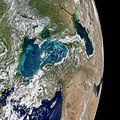파일:Turquoise Swirls in the Black Sea.jpg

미리 보기 크기: 600 × 600 픽셀 다른 해상도: 240 × 240 픽셀 | 480 × 480 픽셀 | 768 × 768 픽셀 | 1,024 × 1,024 픽셀 | 2,048 × 2,048 픽셀 | 7,000 × 7,000 픽셀
원본 파일 (7,000 × 7,000 픽셀, 파일 크기: 16.71 MB, MIME 종류: image/jpeg)
파일 역사
날짜/시간 링크를 클릭하면 해당 시간의 파일을 볼 수 있습니다.
| 날짜/시간 | 섬네일 | 크기 | 사용자 | 설명 | |
|---|---|---|---|---|---|
| 현재 | 2017년 6월 12일 (월) 17:55 |  | 7,000 × 7,000 (16.71 MB) | Originalwana | {{Information |Description ={{en|1=Most summers, jewel-toned hues appear in the Black Sea. The turquoise swirls are not the brushstrokes of a painting; they indicate the presence of phytoplankton, which trace the flow of water currents and eddies. O... |
이 파일을 사용하는 문서
다음 문서 1개가 이 파일을 사용하고 있습니다:
이 파일을 사용하고 있는 모든 위키의 문서 목록
다음 위키에서 이 파일을 사용하고 있습니다:
- ar.wikipedia.org에서 이 파일을 사용하고 있는 문서 목록
- بوابة:محتوى متميز
- ويكيبيديا:صور مختارة
- ويكيبيديا:صور مختارة/الفضاء والكون
- ويكيبيديا:صور مختارة/الفضاء والكون/نظرة إلى الخلف
- بوابة:محتوى متميز/محتويات
- بوابة:محتوى متميز/محتويات/صور مختارة
- بوابة:محتوى متميز/الرئيسية
- علوم الأرض ناسا
- ويكيبيديا:يوم ويكيبيديا العربية التاسع عشر
- مستخدم:أيوب/يوم ويكيبيديا العربية التاسع عشر
- ويكيبيديا:يوم ويكيبيديا العربية التاسع عشر/تنفيذ الأهداف
- ويكيبيديا:ترشيحات الصور المختارة/البحر الأسود
- ويكيبيديا:صورة اليوم المختارة/أغسطس 2023
- قالب:صورة اليوم المختارة/2023-08-31
- be-tarask.wikipedia.org에서 이 파일을 사용하고 있는 문서 목록
- bn.wikibooks.org에서 이 파일을 사용하고 있는 문서 목록
- crh.wikipedia.org에서 이 파일을 사용하고 있는 문서 목록
- cs.wikipedia.org에서 이 파일을 사용하고 있는 문서 목록
- cv.wikipedia.org에서 이 파일을 사용하고 있는 문서 목록
- dz.wikipedia.org에서 이 파일을 사용하고 있는 문서 목록
- en.wikipedia.org에서 이 파일을 사용하고 있는 문서 목록
- fa.wikipedia.org에서 이 파일을 사용하고 있는 문서 목록
- fa.wikibooks.org에서 이 파일을 사용하고 있는 문서 목록
- frp.wikipedia.org에서 이 파일을 사용하고 있는 문서 목록
- fr.wikipedia.org에서 이 파일을 사용하고 있는 문서 목록
- gl.wikipedia.org에서 이 파일을 사용하고 있는 문서 목록
- he.wikipedia.org에서 이 파일을 사용하고 있는 문서 목록
- hu.wikipedia.org에서 이 파일을 사용하고 있는 문서 목록
- hy.wikipedia.org에서 이 파일을 사용하고 있는 문서 목록
- hy.wikibooks.org에서 이 파일을 사용하고 있는 문서 목록
- it.wiktionary.org에서 이 파일을 사용하고 있는 문서 목록
- ka.wikipedia.org에서 이 파일을 사용하고 있는 문서 목록
- lbe.wikipedia.org에서 이 파일을 사용하고 있는 문서 목록
- lb.wikipedia.org에서 이 파일을 사용하고 있는 문서 목록
이 파일의 더 많은 사용 내역을 봅니다.




